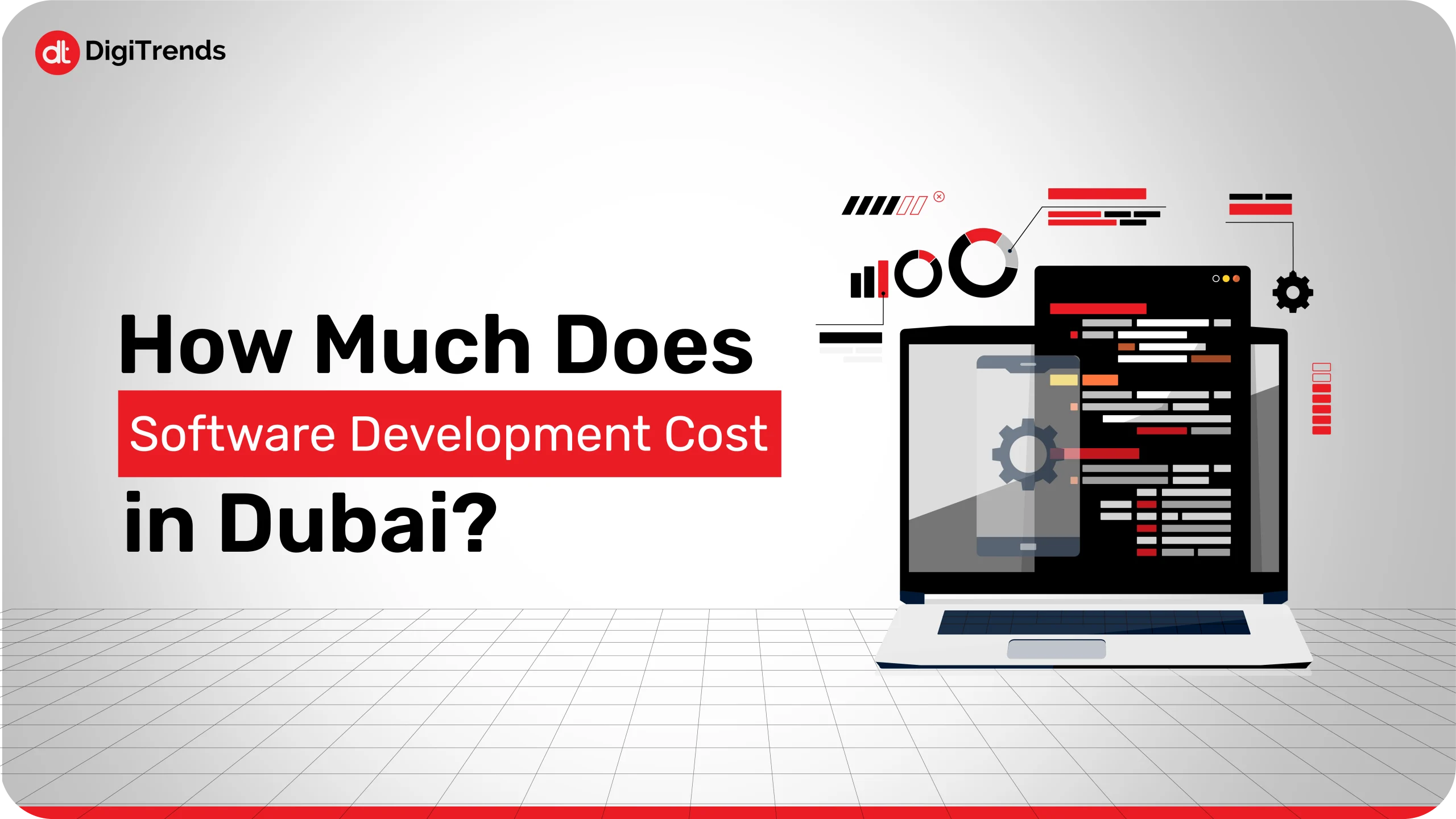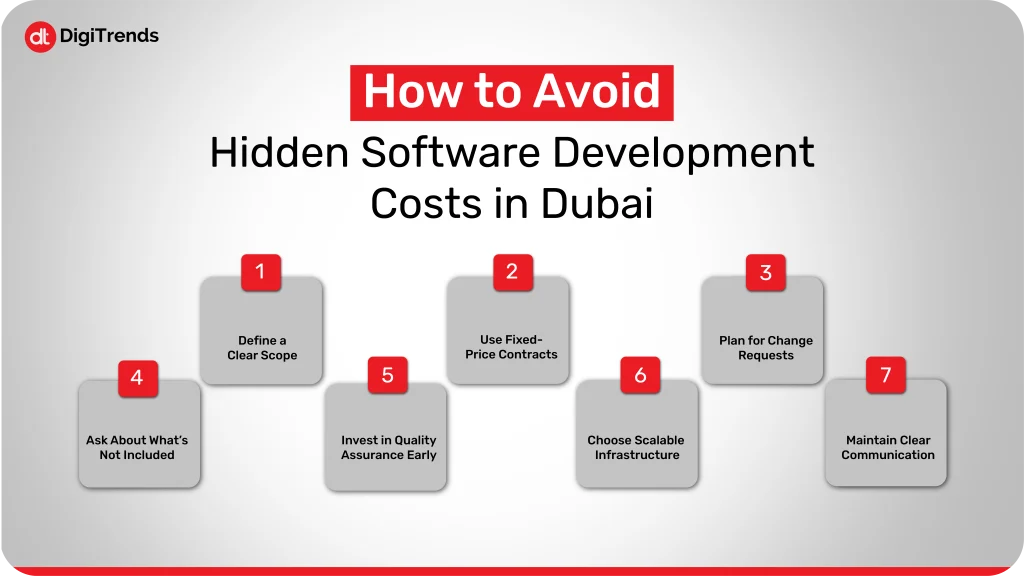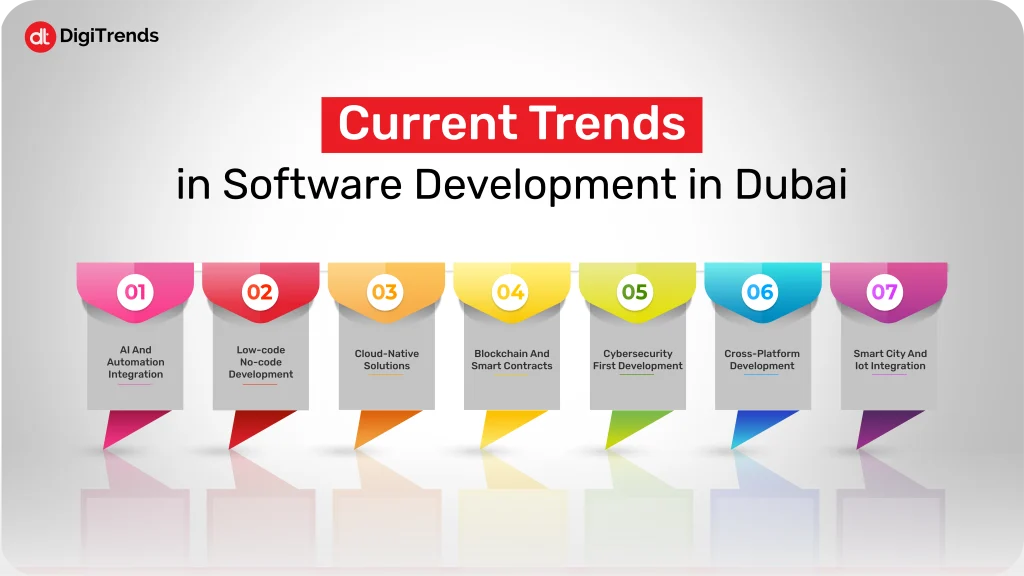
Predictive Analytics in Healthcare: The Future of Patient Care
Explore the predictive analytics in healthcare examples, Its benefits, and the impact it’s creating for both patients and professionals.
Continue Reading
It is no secret that Dubai is a global tech and innovation hub, with numerous opportunities in the tech sector as well as other sectors, due to its business-friendly regulations and a strong emphasis on digital transformation across industries.
As startups and businesses in Dubai grow, so does the demand for custom software development, particularly in sectors such as fintech, real estate, healthcare, and e-commerce. Organizations are looking to enhance their operations, improve customer experiences, and stay competitive in the competitive market through software development.
Dubai offers a mix of homegrown tech startups and international organizations that offer everything from basic MVP to enterprise-grade software development. According to Statista, the UAE’s software development market is projected to be valued at USD 2.49 billion by the year 2030. Due to this growing demand, software development services in Dubai have become more dynamic, competitive, and diverse.
Understanding the software development cost in Dubai can be tough, but don’t worry, this blog will cover everything you need to know, from project complexity and team composition to hidden costs and the steps of development.
Let’s have a look at the custom software development cost in Dubai:
To estimate Dubai software development pricing, you will need to consider the complexity of your app, the team’s location, the design of the software, and much more. Whether you are a startup, looking to develop an MVP, or an enterprise looking to launch a scalable software, you will have to plan the components and budget accordingly.
Let’s have a look at the basic breakdown of software development costs in Dubai:
| Factor | Estimated Cost (USD) | Description |
| Software Type | 15,000 – 300,000+ | Basic apps, mid-level platforms, or complex enterprise systems |
| Development Team | 75 – 400/hour | Freelancers, local agencies, or outsourced international teams |
| Technology Stack | Varies by stack complexity | Standard (React, Node.js) vs. advanced (AI, Blockchain) |
| UI/UX Design | 10,000 – 50,000 | Custom user interface and experience design |
| Project Duration | Directly affects the overall cost | Short-term (1–3 months) to long-term (6+ months) |
| Maintenance | 2,000 – 10,000/month | Ongoing updates, bug fixes, and monitoring |
| Cloud Infrastructure | 500 – 10,000+/month | Hosting, storage, backup, and security |
| Third-Party Integrations | Based on integration complexity | APIs, payment gateways, CRMs, and other external tools |
The estimated cost of developing software in Dubai ranges from $50,000 – $300,000+, but the costs highly depend on a lot of factors like the complexity of the app, the type of design you want, the software security and compliance, and much more.
This all must seem very overwhelming, but don’t worry, we will cover every factor that affects the software development cost in Dubai and explore it in detail, so you can plan every component of your app accordingly.
Let’s first have a look at the easiest way of estimating the cost of software development in Dubai:

You might be thinking, what is the easiest way to calculate software development cost in Dubai?
Here’s a very easy way you can calculate the costs:
Development Hours x Hourly Rates of Developers = Total Cost
The software development cost in Dubai depends on two major factors, which are development hours and the hourly rates of developers. By combining these two, you can easily get an estimated cost for the software development, according to your requirements.
There are many factors affecting software development costs in the UAE, and it is important to go through every major factor to make informed decisions and optimize your budget.
Let’s have a deep look at the factors affecting software development costs in Dubai:
The complexity of the software is the most important factor that can drive down your costs or take up costs to another level; the more complex your software, the higher the cost. This is because building basic software does not require complex features like real-time data syncing, AI integration, payment systems, and multi-user access levels, but this is all required to build complex software that requires more time and expertise to develop; hence, the costs also increase.
Another factor that is important to consider when thinking about the cost of software development is the development team you choose for your project; the team’s location and expertise matter a lot when estimating the software development cost in Dubai.
For the best balance between cost, quality, and communication, it’s often preferred to hire a team that operates within the region and brings proven expertise to the table. Companies like DigiTrends, which operate in various regions, including the UAE, and offer specialized development services in Dubai, combine deep technical know-how with a strong understanding of local business needs, making them a reliable choice for high-impact software projects.
The design of the software matters a lot, not only because of how it looks, but also because how you want it to look will also affect the costs of development. A custom, intuitive, and responsive user interface can enhance user experience, but it adds to design and front-end development costs. Highly interactive or animated interfaces increase effort and design hours.
Choosing newer or niche technologies (like Rust, Kotlin Multiplatform, or machine learning libraries) might lead to higher costs due to limited developer availability and longer development cycles.
Using APIs, cloud hosting, payment gateways, CRMs, or analytics platforms can add licensing or subscription fees, plus extra time for integration and testing.
Industries like finance, healthcare, and education often require adherence to strict regulations (e.g., GDPR, HIPAA, ISO). Ensuring compliance adds extra planning, development, and testing phases.
If your platform is expected to grow in user base or features, building it to scale from the start (e.g., with modular architecture, load balancing, or cloud-native infrastructure) will require additional investment.
Understanding these factors allows businesses to plan effectively, prioritize features, and choose the right development approach for their goals. By anticipating these variables, you can avoid unexpected expenses and ensure a smoother development journey.
While the initial costs of development might be clear and straightforward, some costs are often unexpected and will have you thinking, “that came out of nowhere”. To avoid this, you need ot be prepared for some hidden costs that you can encounter in software development.
Let’s have a look at the hidden software development cost in Dubai, so that you can avoid surprises and budget accurately:
Adding new features or changing requirements mid-project can lead to extended timelines and increased costs. It’s important to clearly define the scope from the start and stick to it as much as possible to avoid scope creep.
Some features may rely on paid third-party services or APIs (e.g., maps, payment gateways, analytics), which come with ongoing subscription or licensing fees.
Publishing apps on platforms like the Apple App Store or Google Play involves annual fees. Similarly, cloud hosting and storage (e.g., AWS, Azure) can accumulate costs over time, especially as your user base grows.
Ongoing support, bug fixes, and compatibility updates are often not included in the initial development budget. These are crucial for performance, security, and user satisfaction.
Comprehensive QA is essential but sometimes underquoted. Complex software may require extensive testing across devices, platforms, and edge cases, which can extend timelines and costs.
Internal training, user manuals, or system documentation may be needed, especially for enterprise solutions, but are often considered add-ons rather than part of the base development package.
By identifying these hidden costs early, businesses can set more realistic budgets and avoid disruption during development or post-launch. Transparency, thorough planning, and clear communication with your development team are key to keeping your project financially on track.

Hidden costs can derail even the most well-planned software projects. Fortunately, with the right strategies and planning, many of these surprises can be avoided.
Let’s have a look at how you can avoid hidden custom software development costs in Dubai:
Start with a detailed requirements document that outlines every feature, user flow, and functionality. Avoid vague goals and ensure all stakeholders are aligned from the beginning.
For well-defined projects, a fixed-price model can provide cost predictability. If you’re working with an hourly model, set clear milestones and timelines to maintain control.
Set aside a contingency budget (typically 10–15%) for potential changes or new feature requests. This helps accommodate evolving needs without disrupting the main budget.
During vendor discussions, ask what services are excluded from the quote, such as post-launch support, documentation, testing, or training, so that you can factor them in upfront.
Don’t leave testing until the end. Incorporating QA throughout development helps identify bugs and usability issues early, reducing the cost and time to fix them later.
Select cloud services and architecture that support future growth without requiring complete redevelopment. Scalable solutions reduce long-term costs and technical debt.
Keep in regular contact with your development team. Frequent updates and reviews can help catch scope changes, delays, or inefficiencies before they turn costly.
By taking a proactive approach and prioritizing clarity, communication, and thorough planning, businesses can minimize the risk of hidden expenses. These steps not only help keep the project within budget but also contribute to a smoother, more predictable development process.
Developing software in Dubai involves a mix of technical planning and local business considerations. Whether you’re building a mobile app, SaaS platform, or enterprise solution, following a structured approach ensures better outcomes.
Let’s have a look at the step-by-step guide to enterprise-grade software development in Dubai:
Start by identifying your business goals, target users, core features, and technical needs. The more detailed your vision, the easier it is for development teams to align and estimate costs accurately.
Evaluate software development companies based in Dubai or with experience in the UAE market. Consider their portfolio, client reviews, pricing models, and knowledge of local regulations.
Once a partner is selected, you’ll receive a project proposal outlining timelines, technologies, team structure, and deliverables. This phase includes creating a detailed roadmap or project timeline.
Designers work on user interface layouts, branding, wireframes, and prototypes to ensure the software offers a smooth and intuitive experience tailored to your audience.
This is where coding begins. Depending on your project’s scale, developers work in sprints, building out the backend, frontend, and integrating APIs, databases, or third-party tools.
Rigorous QA is conducted to test performance, usability, security, and compatibility. Dubai-based businesses may also require testing for compliance with local data privacy standards.
Once the application passes testing, it is deployed on live servers or submitted to app stores. Hosting may be set up on cloud platforms like AWS, Azure, or local UAE data centers for compliance.
Some agencies offer training sessions, user manuals, and admin guides to ensure your team knows how to use and manage the software post-launch.
After launch, ongoing updates, bug fixes, server monitoring, and feature enhancements are essential to ensure your product remains stable and competitive.
Following these structured steps helps ensure your software project is aligned with both your business goals and the unique dynamics of the Dubai market. With the right planning and execution, you can build scalable, efficient, and locally compliant solutions that deliver long-term value.
Contact us for detailed cost estimates and custom software solutions designed for the UAE market.
Get StartedEmbarking on a software development journey can be exciting, but certain missteps early on can lead to delays, budget overruns, or subpar outcomes.
Let’s have a look at the most common pitfalls and how to steer clear of them:
By recognizing and proactively addressing these mistakes, you’ll position your project for smoother execution, on‑time delivery, and a successful launch.

Dubai’s rapid push toward digital transformation has led to the adoption of cutting-edge technologies and agile development practices across industries. As the city positions itself as a global innovation hub, several software development trends are shaping how businesses build, deploy, and scale digital solutions.
Let’s have a look at the current trends in software development:
From intelligent chatbots in e-commerce to predictive analytics in finance and healthcare, AI is now a core component of many new software projects. Dubai businesses are investing in machine learning models to streamline operations, personalize experiences, and enhance decision-making. According to Digital Dubai, by 2030, AI is expected to generate USD 320 billion in value for the Middle East.
To accelerate time-to-market and empower non-technical teams, many companies in Dubai are adopting low-code or no-code platforms. These tools are especially popular among startups and SMEs looking to validate ideas without a heavy upfront investment in development quickly.
With scalability and remote access being top priorities, cloud-first development, leveraging platforms like AWS, Azure, and local UAE-based cloud providers, is on the rise. Businesses are opting for microservices and containerized applications to ensure high performance and reliability.
Driven by Dubai’s vision to become a blockchain-powered city, there’s growing interest in blockchain for sectors like real estate, logistics, and public services. Smart contracts and decentralized applications (dApps) are gaining traction in both private and government-backed initiatives.
As data privacy regulations tighten in the UAE, security is no longer an afterthought. Businesses are integrating robust encryption, secure authentication, and real-time threat monitoring from day one to ensure compliance and protect user data.
To reduce development time and cost, companies are increasingly building apps that work across iOS, Android, and web using frameworks like Flutter and React Native, ensuring broader reach with a single codebase.
With Dubai’s smart city initiatives, software solutions are being designed to integrate with IoT devices, whether it’s for traffic management, smart buildings, or connected healthcare systems. This has created new demand for real-time data processing and interoperability.
These trends highlight Dubai’s commitment to innovation, agility, and digital excellence. By staying aligned with these evolving technologies and practices, businesses can not only future-proof their software investments but also gain a competitive edge in one of the world’s most dynamic tech landscapes.
Software development in Dubai is more than just a technical process; it’s a strategic investment in digital transformation. As the city continues to lead in innovation and smart infrastructure, businesses are increasingly turning to custom software to drive efficiency, engage users, and stay ahead in a competitive market. However, understanding the true cost of development requires a closer look at several layers, from the project scope and tech stack to hidden fees and long-term maintenance.
By carefully evaluating cost breakdowns, potential hidden charges, and the steps involved in development, businesses can plan more effectively and avoid common financial pitfalls. Taking the time to define a clear scope, choose the right partner, and invest in scalability pays off not only during the build phase but also in the sustainability of your solution over time. Dubai’s vibrant tech ecosystem offers world-class opportunities, but success starts with transparency and preparation.
Development partners like DigiTrends combine local market knowledge with global tech expertise to deliver scalable, cost-efficient software solutions tailored to your goals. Whether you’re building an app, platform, or digital product, our team is here to guide you through every step, from planning and design to development and support, ensuring clarity, agility, and value at every stage.
